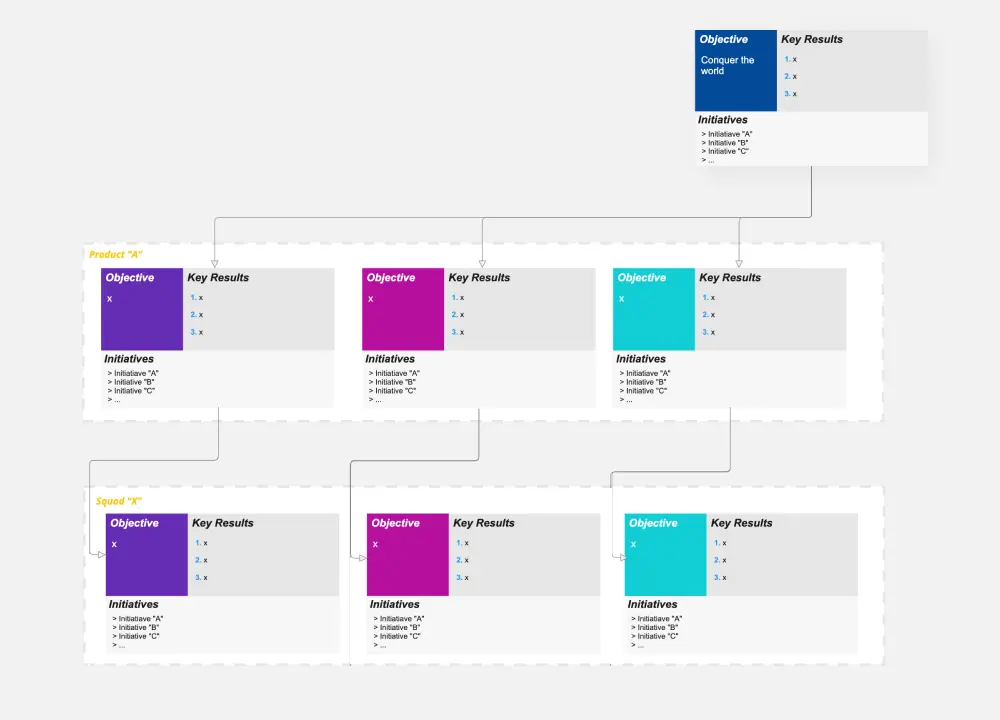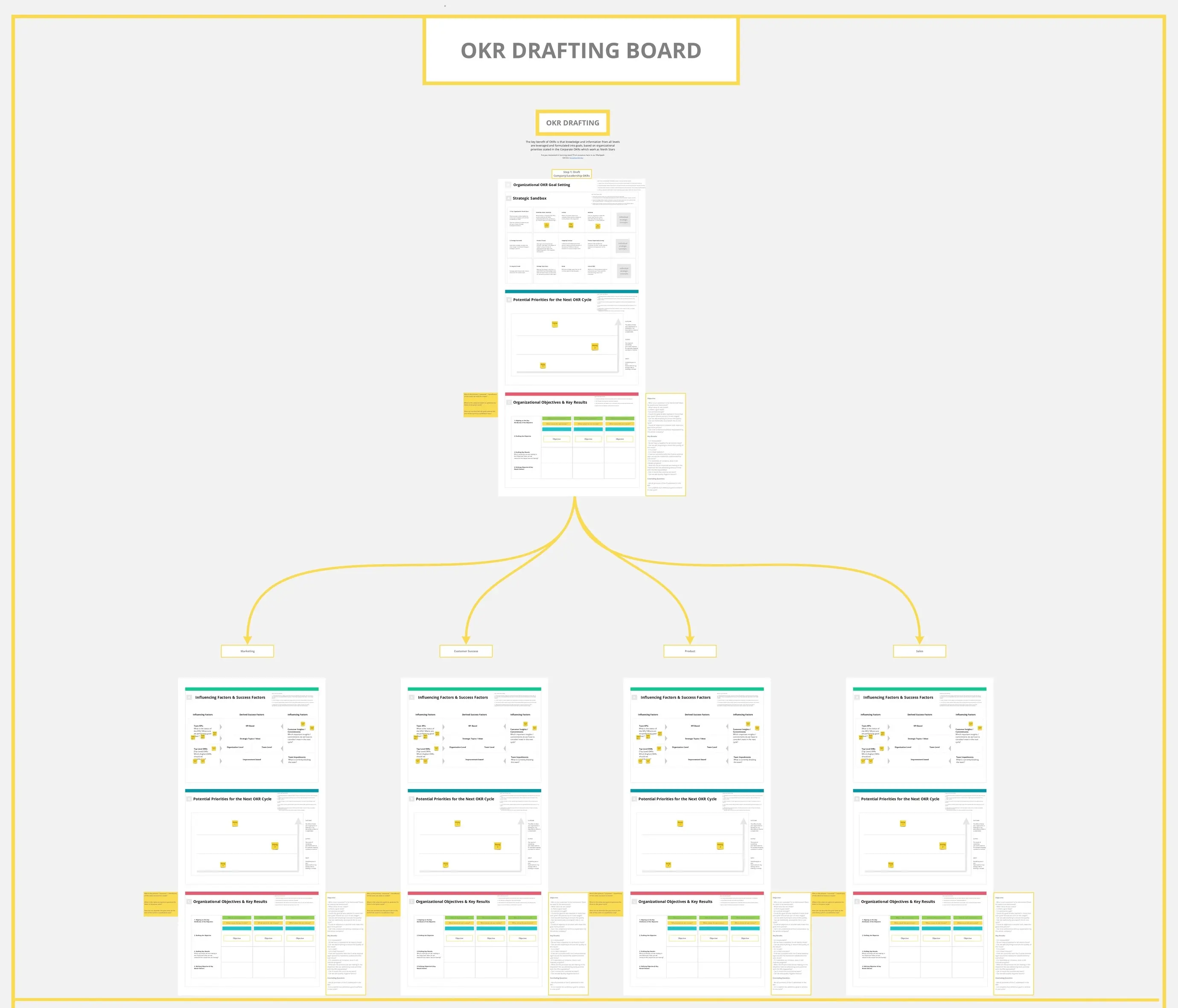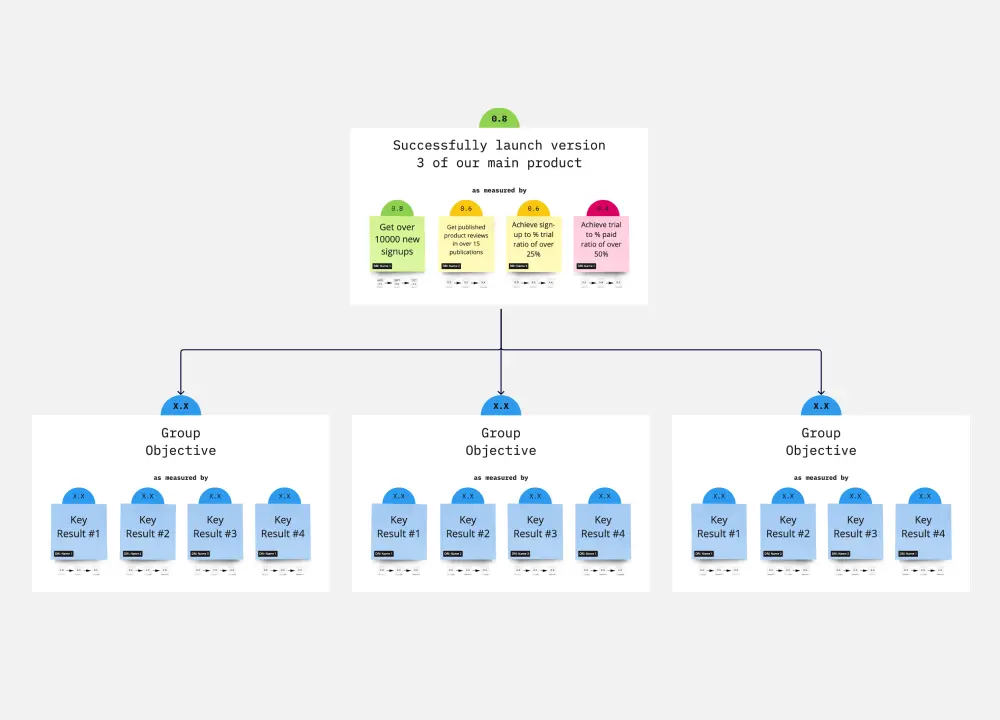OKRs (which stands for “Objectives and Key Results”) is a goal-setting technique used by many great companies, including Google, Intel, Asana, Slack, and even here at Miro! The goal of using OKRs is to improve transparency and alignment across teams by focusing on a key set of goals and tracking progress against them.
At Miro, we like using a board for our OKRs because it helps us to visualize the connections between team, function, and overall company goals. It’s also great tool for discussing and brainstorming new objectives when you are just getting started with the planning process. We recently used this board at our Executive Team offsite to create Miro’s annual objectives.
Here are some tips on how to get your workshop started:
Step 1: Introduction & check-in on previous goals
Use a few minutes at the beginning of your workshop to set expectations for the session and remind people of your planning framework. Whether you're using OKRs or another goal-setting framework, revisit your current goals and their scores with the group and discuss them. Are these goals still relevant for your company? What do you like or not like about the goals? This will give the group a reference point to start planning from.
Step 2: Brainstorm Objectives
Break your brainstorming time into two sections:
Individual Brainstorming (10 min)
Small Group Discussion (25 min)
Brainstorming individually will help the group get their thoughts together before going into the small group discussion and help make sure you’re avoiding any biases. You want to get the best, innovative ideas possible!
Breaking the large group down into small group discussion will help make sure everyone has a chance to share their ideas and build some group consensus before coming back for a larger group discussion. Have groups narrow down and rank their ideas into three categories: Must have, Should Haves, and Nice-to-haves.
Step 3: Rank & discuss
Bring the small groups back together and have them share their rankings. Look at the full group of ideas and begin to discuss which Objectives you think are clear, focused, and most important for the company. The goal is to get your Objectives down to a list of 3-4 by the end of the discussion (no more than that!).
Step 4: Brainstorm metrics (Key Results)
Once you have your list of 3-4 objectives, spend a few minutes brainstorming as many metrics as you can for each Objective. Once you have everything on the board, go through each Objective and discuss and rank the metrics the team brainstormed. Select your top 3 for each Objective -- these metrics will become your Key Results.
Step 5: Final Draft
As a final step, look at your full set of Objectives and OKRs and ask:
Do they represent the most critical things your company should be working on this year?
Are they ambitious but focused?
Are they clear and easy to grasp?
Are the KRs honest representations of how to measure progress towards your Objectives?
If you answer yes to all of these questions, congrats! You have your first draft of goals ready to go!
For next steps:
Share the OKRs draft with functional leaders for feedback
Leadership Team finalizes goals and share with the company
The teams go through the bottoms-up planning
Leadership Team does a Final review of bottom-up planning inputs
Share the final plan & OKRs with the entire organization.
Use the OKR Template to track your progress.

Falon Dominguez
Business Operations Manager @ Miro
Falon leads strategy and planning efforts at Miro, including the company OKR process. Falon was previously at Google and Facebook, and recently graduated from The Wharton School with her MBA.
Categories
Similar templates
Getting started with company OKRs
OKR Board for Product, UX and Engineering Teams

OKR Board for Product, UX and Engineering Teams
The OKR Board for Product, UX, and Engineering Teams template aligns cross-functional teams around common objectives using Objectives and Key Results (OKRs). By setting ambitious goals, defining measurable outcomes, and tracking progress collaboratively, this template fosters alignment and focus. With sections for defining team OKRs, prioritizing initiatives, and monitoring performance, it enables teams to work cohesively towards shared goals. This template serves as a catalyst for driving product innovation and delivering exceptional user experiences.
OKR Drafting Board

OKR Drafting Board
The OKR Drafting Board (New) is a visual tool for defining and tracking Objectives and Key Results (OKRs). It provides a structured framework for setting ambitious goals, defining measurable outcomes, and aligning teams around shared objectives. This template enables organizations to articulate their strategic priorities, track progress transparently, and foster accountability and alignment across teams. By promoting focus, alignment, and agility, the OKR Drafting Board empowers organizations to achieve breakthrough results and drive continuous improvement.
Getting started with company OKRs
OKR Board for Product, UX and Engineering Teams

OKR Board for Product, UX and Engineering Teams
The OKR Board for Product, UX, and Engineering Teams template aligns cross-functional teams around common objectives using Objectives and Key Results (OKRs). By setting ambitious goals, defining measurable outcomes, and tracking progress collaboratively, this template fosters alignment and focus. With sections for defining team OKRs, prioritizing initiatives, and monitoring performance, it enables teams to work cohesively towards shared goals. This template serves as a catalyst for driving product innovation and delivering exceptional user experiences.
OKR Drafting Board

OKR Drafting Board
The OKR Drafting Board (New) is a visual tool for defining and tracking Objectives and Key Results (OKRs). It provides a structured framework for setting ambitious goals, defining measurable outcomes, and aligning teams around shared objectives. This template enables organizations to articulate their strategic priorities, track progress transparently, and foster accountability and alignment across teams. By promoting focus, alignment, and agility, the OKR Drafting Board empowers organizations to achieve breakthrough results and drive continuous improvement.
